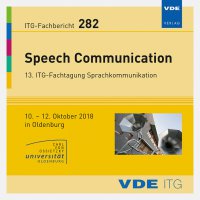Maximum-Likelihood and Maximum-A-Posteriori Perspectives for Blind Channel Identification on Acoustic Sensor Network Data
Conference: Speech Communication - 13. ITG-Fachtagung Sprachkommunikation
10/10/2018 - 10/12/2018 at Oldenburg, Deutschland
Proceedings: Speech Communication
Pages: 5Language: englishTyp: PDF
Personal VDE Members are entitled to a 10% discount on this title
Authors:
Thuene, Philipp; Enzner, Gerald (Institute of Communication Acoustics (IKA), Ruhr-Universität Bochum, 44780 Bochum, Germany)
Abstract:
The emerging field of wireless acoustic sensor networks (ASN) offers promising future applications, but at the same time entails several challenges for audio signal processing. One particular task is that of identifying the acoustical system between a source of interest and the receivers in the form of acoustical transfer functions (ATF). In ASN, ATF estimation is essentially a blind problem due to unknown sensor geometry and unavailable source signal and is further complicated by noisy environments and non-persistent excitation. In this paper, we therefore put the blind identification problem into a frame-based maximum-likelihood (ML) context, before we extend this data-driven method with a-priori information to a new maximum-a-posteriori (MAP) approach. The latter shall compensate for the non-persistent excitation in ASN. We further propose a measure for assessing the accuracy of blindly identified ATF and demonstrate in computer experiments that the MAP approach is superior to ML provided that accurate estimates of the source activity are available.


